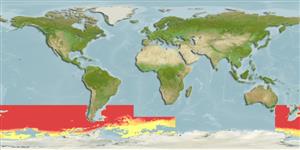Actinopterygii (ray-finned fishes) >
Lophiiformes (Anglerfishes) >
Oneirodidae (Dreamers)
Etymology: Oneirodes: Greek, 'oneiros' = a dream or dreamlike or out of a dream (suggesting this fish is so strange and marvelous that can exist only in dreams) (Ref. 86949).
Environment / Climate / Range
Ecology
Marine; bathypelagic; depth range 700 - 2000 m (Ref. 86949), usually 800 - 1100 m (Ref. 86949). Deep-water, preferred ?; 36°S - 77°S
Southern Ocean: sub-Antarctic and Antarctic waters.
Size / Weight / Age
Maturity: Lm ? range ? - ? cm
Max length : 15.0 cm SL (female)
Short description
Morphology | Morphometrics
Dorsal
soft rays
(total): 5-7;
Anal
soft rays: 4. Characterized by having escal morphology: esca with a stout, internally pigmented appendage, usually bearing a compressed papilla and 2 tapering filaments on distal tip; several small tapering filaments along posterior margin of anterior escal appendage; papilla and filaments of anterior escal appendage unpigmented; rounded or truncated terminal escal papilla with a distal streak of pigment; unpigmented, unbranched tapering posterior escal appendage as long as or shorter than escal bulb; absence of lateral and anterolateral appendages; relatively short and broad subopercle, without indentation on posterodorsal margin; length of ventral fork of opercle 25.2-32.2% SL; ratio of lengths of the dorsal and ventral forks of opercle 0.52-0.59; absence of epibranchial teeth; presence of teeth on pharyngobranchial II; upper jaw teeth 20-37, lower jaw teeth 22-48; teeth on vomer 4-7; dorsal fin rays 5-7; anal fin rays 4; pectoral fin rays 17-19; head length 35.0-46.2% SL; head depth 36.3-48.8% SL; premaxilla length 25.0-35.0% SL; length of lower jaw 38.3-50.0% SL; length of illicium 19.1-28.3% SL (Ref. 86949).
Larvae are epipelagic, young and adults are mesopelagic or bathypelagic (Ref. 47377). Minimum depth from Ref. 58018.
Life cycle and mating behavior
Maturity | Reproduction | Spawning | Eggs | Fecundity | Larvae
Pietsch, T.W., 1990. Oneirodidae. p. 212-213. In O. Gon and P.C. Heemstra (eds.) Fishes of the Southern Ocean. J.L.B. Smith Institute of Ichthyology, Grahamstown, South Africa. (Ref. 5186)
IUCN Red List Status (Ref. 115185)
CITES (Ref. 94142)
Not Evaluated
Threat to humans
Harmless
Human uses
Fisheries: of no interest
More information
Common namesSynonymsMetabolismPredatorsEcotoxicologyReproductionMaturitySpawningFecundityEggsEgg development
Age/SizeGrowthLength-weightLength-lengthLength-frequenciesMorphometricsMorphologyLarvaeLarval dynamicsRecruitmentAbundance
ReferencesAquacultureAquaculture profileStrainsGeneticsAllele frequenciesHeritabilityDiseasesProcessingMass conversion
Tools
Special reports
Download XML
Internet sources
